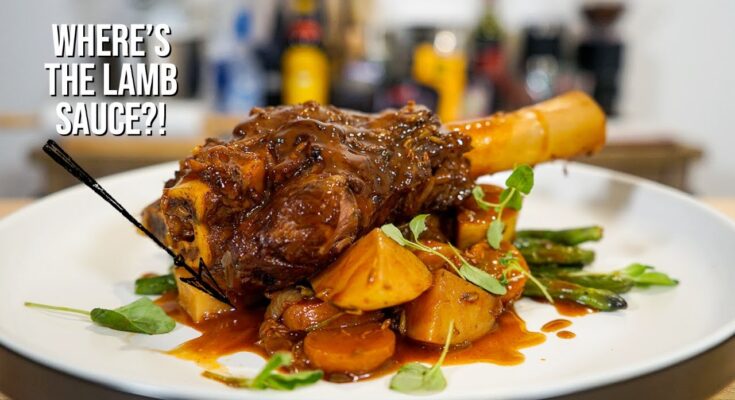Mutton Shank Recipe: If you’re craving a rich, fall-off-the-bone dish that screams flavor and satisfaction, then the mutton shank recipe is what you need in your culinary repertoire.
Perfect for festive occasions or cozy weekend dinners, this dish is a classic favorite in many parts of the world—from Indian kitchens to Mediterranean feasts.
Let’s dive into a foolproof step-by-step guide that walks you through creating the most delicious, tender, and aromatic mutton shank recipe.
What is Mutton Shank?
Mutton shank refers to the portion of meat taken from the lower section of a lamb or goat’s leg. It’s a cut known for its rich, hearty flavor and substantial connective tissue, which transforms into luscious gelatin when slow-cooked. This results in a melt-in-your-mouth texture that’s almost impossible to resist.
Unlike quick-fry cuts like chops or ribs, the shank requires time and patience. It’s typically larger and more sinewy, so it benefits greatly from slow, moist cooking methods. Think of it as the pot roast of mutton—perfect for dishes that involve long simmering in flavorful gravies or broths.
Why Choose Mutton Shank for Cooking?
You might wonder—why go for a tougher cut when there are easier ones to cook? The answer lies in depth of flavor and texture. Mutton shanks are budget-friendly yet incredibly satisfying when cooked right. Here are some reasons why they’re worth the extra time:
- Flavor-Intense: The bone marrow and connective tissues contribute to a depth of flavor that leaner cuts can’t match.
- Juicy and Tender: With proper slow cooking, the meat becomes incredibly tender and practically falls off the bone.
- Great for Gravy: The gelatin released during cooking gives a rich body to the gravy.
- Presentation-Ready: A well-cooked shank looks impressive on the plate and is often a centerpiece dish.
In short, mutton shanks are your go-to choice when you want something luxurious, hearty, and full of character.
Ingredients Required
Main Ingredients
The beauty of a mutton shank dish lies in its simplicity. You don’t need dozens of exotic ingredients—just a few staples and some love. Here’s what you’ll need for a basic recipe that serves 3-4 people:
- 2-3 mutton shanks (bone-in, medium-sized)
- 2 large onions (finely sliced)
- 2 tomatoes (pureed or chopped)
- 2 tablespoons ginger-garlic paste
- 1 cup yogurt (whisked)
- 3-4 tablespoons cooking oil or ghee
- 1 teaspoon turmeric powder
- 2 teaspoons red chili powder
- 1 teaspoon coriander powder
- 1 teaspoon garam masala
- Salt to taste
- Water or mutton stock (for cooking)
These ingredients form the core base for the gravy and ensure the meat absorbs the right amount of spice and flavor during the cooking process.
Optional Ingredients for Enhanced Flavor
If you want to elevate your mutton shank game, consider adding these optional ingredients to deepen the flavor profile:
- Whole spices: Bay leaves, cinnamon sticks, black cardamom, and cloves for that warm, aromatic base.
- Fresh herbs: Cilantro or mint leaves for garnish.
- Saffron: For a luxurious twist.
- Green chilies: For an extra kick.
These additions aren’t mandatory but can take your dish from everyday to extraordinary with very little effort.
Preparing the Mutton Shank
Cleaning and Marinating
Before diving into the actual cooking, a little prep goes a long way. Mutton shanks are best when they’re marinated and allowed to absorb flavors in advance. Here’s how you do it:
- Wash the shanks thoroughly: Use fresh water to clean off any bone dust or unwanted bits. Pat them dry with a paper towel.
- Make a simple marinade: In a bowl, mix yogurt, ginger-garlic paste, turmeric, salt, and a pinch of chili powder.
- Coat the shanks: Rub the marinade generously over the meat, ensuring it gets into all the nooks and crannies.
- Let it rest: Cover and refrigerate for at least 2–4 hours, or overnight for best results.
This marination process breaks down some of the tough fibers and injects the meat with flavor. It’s a crucial step that sets the tone for the final taste.
Tips for Tenderizing Mutton
Tender mutton isn’t just about long cooking times—it starts with how you prep it. Here are a few insider tips:
- Use a meat mallet: Gently pound the shank to break down the muscle fibers before marinating.
- Add papaya paste or meat tenderizer: Especially useful if your mutton is older or very tough.
- Acidic ingredients help: Yogurt, lemon juice, or vinegar in the marinade naturally soften the meat.
These small steps ensure your final dish turns out juicy, flavorful, and fork-tender—exactly how a great mutton shank should be.
Step-by-Step Cooking Process
Step 1 – Searing the Mutton
The first stage of actual cooking involves searing the marinated mutton shanks. This crucial step helps to lock in the juices and adds a rich caramelized flavor to the meat.
- Heat oil or ghee in a heavy-bottomed pot – A Dutch oven or deep pan works best.
- Add whole spices – Toss in bay leaves, cardamom pods, a cinnamon stick, and a few cloves. Let them sizzle for a few seconds.
- Add marinated shanks – Carefully place each piece in the hot oil. Let them brown on each side for about 3–5 minutes.
- Do not overcrowd the pan – If necessary, sear in batches to ensure even browning.
- Set aside – Once all the shanks are beautifully seared with a golden crust, remove and set them aside.
Searing helps in building flavor layers, as the browned bits (fond) stuck to the bottom of the pan will later enrich the gravy. Don’t skip this—it’s a small step with big impact!
Step 2 – Creating the Gravy Base
After removing the mutton, it’s time to create a luxurious gravy that will cradle those shanks in rich, flavorful warmth.
- Use the same pot – Add a bit more oil if needed and sauté sliced onions until they turn golden brown.
- Add ginger-garlic paste – Cook until the raw smell disappears, usually 2–3 minutes.
- Mix in the tomato puree – Stir and let it cook until the oil starts to separate from the masala.
- Spice it up – Add turmeric, red chili, coriander powder, and a pinch of salt. Mix well.
- Yogurt magic – Reduce the heat and add the whisked yogurt slowly while stirring continuously to prevent curdling.
Let this mix simmer for about 5–7 minutes. It should turn into a thick, rich paste. This is your base—a flavor powerhouse that’s going to seep into every bite of the shank.
Step 3 – Slow Cooking to Perfection
This is where patience pays off. The goal is to cook the shanks low and slow until the meat is tender and falls off the bone.
- Reintroduce the seared shanks into the gravy.
- Add enough water or stock to submerge the shanks halfway.
- Cover and cook – Reduce the heat to low and let it simmer gently for 1.5 to 2 hours. Alternatively, you can pressure cook it for 4–5 whistles.
- Stir occasionally – Make sure nothing sticks to the bottom. Add more water if needed.
- Final touch of garam masala – Sprinkle it towards the end and give it one last gentle stir.
When the mutton is fork-tender and the gravy has thickened to a rich, silky consistency, you’re done. The aroma will tell you—you’ve just cooked something truly special.
Serving Suggestions and Final Touches
Ideal Side Dishes
A dish as rich as mutton shank deserves worthy companions. Whether you’re hosting a dinner party or enjoying a family meal, pairing it with the right sides can enhance the whole experience.
- Steamed Basmati Rice: A classic choice. The lightness of the rice soaks up the gravy beautifully.
- Butter Naan or Roti: Perfect for scooping up every last bit of that sauce.
- Jeera Rice or Pulao: Add a mildly spiced rice to complement the boldness of the mutton.
- Mashed Potatoes or Couscous: For a Western twist, these absorb the juices wonderfully.
Make it a complete meal with a crisp salad or a yogurt-based side like raita to balance the richness.
Garnishing and Presentation Tips
You eat with your eyes first, right? So don’t skip the garnish. Even a rustic dish like this can look restaurant-worthy with a few final touches:
- Freshly chopped coriander or mint leaves – Adds a pop of green and freshness.
- Julienned ginger – Adds zing and visual contrast.
- A squeeze of lemon – Brightens up the entire dish.
- Serve in a deep bowl or clay pot – Keeps it warm and adds to the traditional feel.
Use a large spoon to pour the luscious gravy over the meat and serve it hot. Trust us, the oohs and aahs from your guests will make it all worth it.
Customizing the Recipe for Different Tastes
Regional Variations in Mutton Shank Recipes
One of the best things about cooking is how a single dish can vary from one region to another while retaining its soul. Mutton shank recipes are no exception—they’re tailored and twisted beautifully across culinary traditions.
- Indian Style (Rogan Josh or Nihari): Expect a heavily spiced gravy, slow-cooked with earthy flavors, often enjoyed with naan or rice. Kashmiris might add fennel and dry ginger powder; Hyderabadi versions include coconut and curry leaves.
- Middle Eastern (Ossobuco or Shuwa): These typically feature warm spices like cinnamon and cumin, sometimes cooked in a tomato-rich base or buried underground with herbs for hours.
- Western (Braised Shanks): Usually simmered in red wine, garlic, onions, and herbs. The meat is often paired with creamy mashed potatoes or crusty bread.
Every variation tells a story—whether it’s the saffron of Persia or the garam masala of India, there’s no limit to how you can experiment with this versatile cut.
Spicy or Mild? Adjusting the Heat
Everyone’s spice tolerance is different. Here’s how you can tweak the heat levels to suit your audience:
- For a mild version: Reduce the chili powder and skip green chilies. Use paprika for color without the fire.
- For spice lovers: Add crushed black pepper, slit green chilies, or even a dash of cayenne for an extra kick.
- Balance it out: A splash of cream or a dollop of butter at the end mellows the heat and enriches the flavor.
This dish is as adaptable as it is delicious. Tailor it to your liking and don’t be afraid to experiment.
Storage and Reheating Tips
Mutton shank recipes often taste even better the next day as the flavors develop further. That said, proper storage is essential to retain taste and texture.
- Refrigeration: Store in an airtight container and refrigerate for up to 3 days.
- Freezing: Cool the dish completely before freezing. Store in portioned containers and consume within a month.
- Reheating: Use a stovetop for best results. Heat slowly on medium-low and add a splash of water or stock to revive the gravy.
Avoid microwaving directly from the fridge or freezer—it might dry out the meat or make the gravy separate. A little patience ensures your leftovers are just as mouthwatering.
Common Mistakes to Avoid
Cooking mutton shank is a labor of love, but a few common mistakes can ruin the dish. Here’s how to avoid them:
- Skipping the marination: Without marinating, the meat may remain tough and flavorless.
- Overcrowding during searing: This can steam the meat instead of browning it. Sear in batches.
- Using high heat for slow cooking: This toughens the meat. Low and slow is the golden rule.
- Neglecting to stir the gravy: This might lead to sticking or burning at the bottom of the pan.
- Adding too much water: Always add water gradually. The gravy should coat the shank, not drown it.
Stick to these pointers, and you’ll consistently turn out a crowd-pleasing dish every time.
Nutritional Information and Health Benefits
Mutton shank isn’t just delicious—it also comes with a decent nutritional profile when cooked right.
| Nutrient | Approximate Value (per 100g cooked) |
|---|---|
| Calories | 250–300 kcal |
| Protein | 20–25g |
| Fat | 18–22g (depends on trimming) |
| Iron | 2.5 mg |
| Vitamin B12 | 2.6 µg |
Health benefits include:
- Rich in protein: Great for muscle repair and maintenance.
- Iron and B12: Helps fight fatigue and supports cognitive function.
- Gelatin and collagen: Supports joint and skin health, especially when slow-cooked with bones.
While indulgent, it’s easy to keep this dish nutritious by trimming visible fat, avoiding too much oil, and pairing it with fresh vegetables or whole grains.
FAQs about Mutton Shank Recipe
1. Can I use a pressure cooker for mutton shank?
Yes! A pressure cooker reduces cooking time significantly. Cook on high for 4–5 whistles and then simmer for 10–15 minutes for best results.
2. How do I know when the mutton shank is fully cooked?
The meat should be tender enough to pull away from the bone easily. You can test it with a fork or knife—if it cuts smoothly, it’s done.
3. What can I use instead of yogurt for marination?
You can substitute with buttermilk, cream, or even lemon juice. The goal is to tenderize and add flavor.
4. Can I cook mutton shank in the oven?
Absolutely. After searing, transfer the shanks and gravy to a Dutch oven and bake at 160°C (320°F) for 2.5–3 hours.
5. What drinks pair well with this dish?
Try a full-bodied red wine, spiced lassi, or mint lemonade. These beverages balance the richness and enhance the overall experience.
Conclusion
There you have it—a detailed, foolproof guide to making the ultimate mutton shank recipe. From selecting the right cut to serving it with style, every step plays a part in crafting a meal that’s hearty, comforting, and utterly satisfying. Whether you’re making it for a special dinner or just to treat yourself, this recipe delivers every single time.
Remember, cooking is a journey. The more you practice, tweak, and taste, the better you get. Don’t be afraid to make it your own—add your favorite spices, adjust the consistency, or play around with sides. Just give it time, patience, and a little love, and you’ll have a dish that turns heads and wins hearts.



